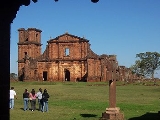
Jesuit Reductions
Encyclopedia
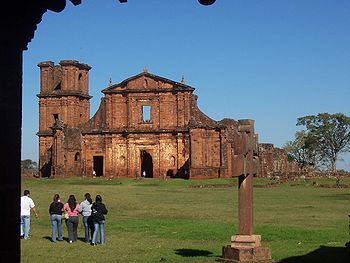
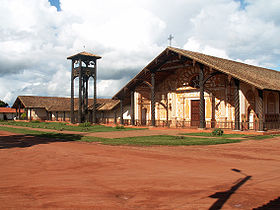
A Jesuit Reduction was a type of settlement for indigenous people in Latin America
Latin America
Latin America is a region of the Americas where Romance languages – particularly Spanish and Portuguese, and variably French – are primarily spoken. Latin America has an area of approximately 21,069,500 km² , almost 3.9% of the Earth's surface or 14.1% of its land surface area...
created by the Jesuit Order
Society of Jesus
The Society of Jesus is a Catholic male religious order that follows the teachings of the Catholic Church. The members are called Jesuits, and are also known colloquially as "God's Army" and as "The Company," these being references to founder Ignatius of Loyola's military background and a...
during the 17th and 18th centuries. In general, the strategy of the Spanish Empire was to gather native populations into centers called Indian Reductions
Indian Reductions
Reductions were settlements founded by the Spanish colonizers of the New World with the purpose of assimilating indigenous populations into European culture and religion.Already since the beginning of the Spanish presence in the Americas, the Crown had been concerned...
(reducciones de indios), in order to Christianize
Christianization
The historical phenomenon of Christianization is the conversion of individuals to Christianity or the conversion of entire peoples at once...
, tax, and govern them more efficiently. The Jesuit interpretation of this strategy was implemented primarily in an area that corresponds to modern day Paraguay
Paraguay
Paraguay , officially the Republic of Paraguay , is a landlocked country in South America. It is bordered by Argentina to the south and southwest, Brazil to the east and northeast, and Bolivia to the northwest. Paraguay lies on both banks of the Paraguay River, which runs through the center of the...
amongst the Tupi-Guarani peoples. Later reductions were extended into areas now part of Argentina
Argentina
Argentina , officially the Argentine Republic , is the second largest country in South America by land area, after Brazil. It is constituted as a federation of 23 provinces and an autonomous city, Buenos Aires...
, Brazil
Brazil
Brazil , officially the Federative Republic of Brazil , is the largest country in South America. It is the world's fifth largest country, both by geographical area and by population with over 192 million people...
, and Bolivia
Bolivia
Bolivia officially known as Plurinational State of Bolivia , is a landlocked country in central South America. It is the poorest country in South America...
.
Jesuit reductions were different from the reductions in other regions because the indigenous people (Indians) were expected to convert to Christianity but not necessarily to European culture. Under the leadership of both the Jesuits and native cacique
Cacique
Cacique is a title derived from the Taíno word for the pre-Columbian chiefs or leaders of tribes in the Bahamas, Greater Antilles, and the northern Lesser Antilles...
s, the reductions achieved a high degree of autonomy
Autonomy
Autonomy is a concept found in moral, political and bioethical philosophy. Within these contexts, it is the capacity of a rational individual to make an informed, un-coerced decision...
within the Spanish colonial empire
Spanish Empire
The Spanish Empire comprised territories and colonies administered directly by Spain in Europe, in America, Africa, Asia and Oceania. It originated during the Age of Exploration and was therefore one of the first global empires. At the time of Habsburgs, Spain reached the peak of its world power....
. With the use of Indian labour, the reductions became economically successful. When their existence was threatened by the incursions of Bandeirante slave traders, Indian militia were created that fought effectively against the colonists. The resistance by the Jesuit reductions to slave raids, as well as their high degree of autonomy and economic success, have been cited as contributing factors to the expulsion of the Jesuits from the Americas in 1767. The Jesuit reductions present a controversial chapter of the evangelisational history of the Americas, and are variously described as jungle utopia
Utopia
Utopia is an ideal community or society possessing a perfect socio-politico-legal system. The word was imported from Greek by Sir Thomas More for his 1516 book Utopia, describing a fictional island in the Atlantic Ocean. The term has been used to describe both intentional communities that attempt...
s or as theocratic regimes of terror.
History
In the 16th century, priests of different religious ordersRoman Catholic religious order
Catholic religious orders are, historically, a category of Catholic religious institutes.Subcategories are canons regular ; monastics ; mendicants Catholic religious orders are, historically, a category of Catholic religious institutes.Subcategories are canons regular (canons and canonesses regular...
set out to evangelize the Americas
European colonization of the Americas
The start of the European colonization of the Americas is typically dated to 1492. The first Europeans to reach the Americas were the Vikings during the 11th century, who established several colonies in Greenland and one short-lived settlement in present day Newfoundland...
, bringing Christianity to indigenous communities. The colonial governments and missionaries agreed on the strategy of gathering the often nomad
Nomad
Nomadic people , commonly known as itinerants in modern-day contexts, are communities of people who move from one place to another, rather than settling permanently in one location. There are an estimated 30-40 million nomads in the world. Many cultures have traditionally been nomadic, but...
ic indigenous populations in larger communities called reductions in order to more effectively govern, tax, and Christianize them. Reductions generally were also construed as an instrument to make the Indians adopt European lifestyles and values, which was not the case in the Jesuit reductions, where the Jesuits allowed the Indians to retain many of their pre-colonial cultural practices. In Mexico the policy was called congregación, and also took the form of the hospitals of Vasco de Quiroga
Vasco de Quiroga
Vasco de Quiroga was the first bishop of Michoacán, Mexico and one of the judges in the second Audiencia that governed New Spain from January 10, 1531 to April 16, 1535....
, and the Franciscan Missions of California
California
California is a state located on the West Coast of the United States. It is by far the most populous U.S. state, and the third-largest by land area...
, and in Portuguese Brazil they were known as aldeias. Legally, under colonial rule, Indians were classified as minors, in effect children, to be protected and guided to salvation by European missionaries.
The Jesuits, only formally founded in 1540, were relatively late arrivals in the New World, from about 1570, especially compared to the Dominicans and Franciscans, and therefore had to look to the frontiers of colonization for mission areas. The Jesuit reductions originated in the early seventeenth century when the Bishop Lizarraga asked for missionaries for Paraguay. In 1609, acting under instructions from Phillip III
Philip III of Spain
Philip III , also known as Philip the Pious, was the King of Spain and King of Portugal and the Algarves, where he ruled as Philip II , from 1598 until his death...
, the Spanish governor of Asunción made a deal with the Jesuit Provinical of Paraguay. The Jesuits agreed to set up hamlets at strategic points along the Paraná river, that were populated with Indians and maintained a separation from Spanish towns. The Jesuits were to "enjoy a tax holiday for ten years" which extended longer. This mission strategy continued for 150 years until the Jesuits were expelled in 1767. Fundamentally the purpose, as far as the government was concerned, was to safeguard the frontier with the reductions where Indians were introduced to European culture. In 1609 three Jesuits began the first mission in San Ignacio Guazú. In the next 25 years, 15 missions were founded in the province of Guairá
Guairá
Guairá may refer to:* Guairá Department, Paraguay* Salto del Guairá, Paraguay...
—but since some of these were within the Portuguese area they were subjected to frequent destructive raids by Bandeirantes of São Paulo
São Paulo
São Paulo is the largest city in Brazil, the largest city in the southern hemisphere and South America, and the world's seventh largest city by population. The metropolis is anchor to the São Paulo metropolitan area, ranked as the second-most populous metropolitan area in the Americas and among...
to enslave the Indians. In 1631, most of the reductions moved west into Uruguay, which was under Spanish jurisdiction, in some cases to be re-opened from the 1680s onwards.
The missions also secured the Spanish Crown
Crown of Castile
The Crown of Castile was a medieval and modern state in the Iberian Peninsula that formed in 1230 as a result of the third and definitive union of the crowns and parliaments of the kingdoms of Castile and León upon the accession of the then King Ferdinand III of Castile to the vacant Leonese throne...
's permission, and some arms, to raise militias of Indians to defend the reductions against raids. The bandeirantes followed the reductions into Spanish territory and in 1641 the Indian militia stopped them at Mbororé. When the Jesuits were expelled from the Spanish realm in 1767, the reductions slowly died out, becoming victims of slave raids or being absorbed into European society. Some of the Reductions have continued to be inhabited as towns while most have been abandoned and remain only as ruins. Córdoba, Argentina
Córdoba, Argentina
Córdoba is a city located near the geographical center of Argentina, in the foothills of the Sierras Chicas on the Suquía River, about northwest of Buenos Aires. It is the capital of Córdoba Province. Córdoba is the second-largest city in Argentina after the federal capital Buenos Aires, with...
, the largest city associated with the reductions, was atypical as a Spanish settlement predated the Jesuits, and functioned as a centre for the Jesuit presence with a novitiate
Novitiate
Novitiate, alt. noviciate, is the period of training and preparation that a novice monastic or member of a religious order undergoes prior to taking vows in order to discern whether they are called to the religious life....
centre, and a college that is now the local university. The Córdoba mission was taken over by the Franciscans in 1767. Many have been declared UNESCO World Heritage sites, including six of the Jesuit Missions of the Chiquitos
Jesuit Missions of the Chiquitos
The Jesuit Missions of the Chiquitos are in the Santa Cruz department of eastern Bolivia. Six of the missions have been designated a UNESCO World Heritage Site. The missions are distinguished by the fusion of European and American Indian cultural influences...
in Bolivia, and others in Brazil, Argentina and Paraguay. There are also two creole language
Creole language
A creole language, or simply a creole, is a stable natural language developed from the mixing of parent languages; creoles differ from pidgins in that they have been nativized by children as their primary language, making them have features of natural languages that are normally missing from...
s, Língua Geral
Língua Geral
Língua Geral is the name of two distinct linguae francae spoken in Brazil, the língua geral paulista , now extinct; and the língua geral amazônica , whose modern descendant is Nheengatu....
and Nheengatu
Nheengatu
The Nheengatu language , often spelled Nhengatu, is an Amerindian language of a Tupi–Guarani family. It is also known by the Portuguese names língua geral da Amazônia and língua geral amazônica, both meaning "Amazonian General Language," or even by the Latin lingua brasilica...
, originating in the reductions and based on Guaraní, Tupi and Portuguese.
Mission life
At the height of the reductions there were around 40 different communities that were home to as many as 150,000 Indians, most of whom were Guaraní, Tupi and ChiquitosChiquitos
Chiquitos means "little ones" in Spanish. The Spanish Conquistadores chose this name for the people living in the rain savannas of what is now the eastern parts of the Santa Cruz Department in Bolivia, when they found the small doors of the Indian huts in the region.Today, this area is called Gran...
. Reductions were laid out according to a standardised plan: the main buildings, like the church, college and churchyard were concentrated around a wide square, with houses facing the other three sides. Each village also provided a house for widows, a hospital, and several warehouses. In the centre of the square, there was a cross and a statue of the mission's patron saint. The reductions were ruled by indigenous chiefs who served as the reduction's governor, but were controlled by the Jesuits. There was a minimum of two Jesuits in a reduction, with more for larger ones. The social organization of the reductions has often been described as extremely efficient; most were self-supporting and even produced surpluses of goods, which they traded to outside communities, which laid the foundation of the belief that Jesuits were guarding immense riches acquired through Indian labour. The main traded produce was the hides of their cattle and yerba mate
Yerba mate
Maté, yerba maté or erva maté , Ilex paraguariensis, is a species of holly native to subtropical South America in northeastern Argentina, Bolivia, southern Brazil, Uruguay and Paraguay...
, leaves drunk somewhat like tea. Initially these were collected from the wild, but later cultivated. A number of trades and skills were taught to some Indians, including even printing, to produce mostly religious texts in indigenous languages, some illustrated by engraving
Engraving
Engraving is the practice of incising a design on to a hard, usually flat surface, by cutting grooves into it. The result may be a decorated object in itself, as when silver, gold, steel, or glass are engraved, or may provide an intaglio printing plate, of copper or another metal, for printing...
s by indigenous artists. In reality the communities were economically successful but hardly constituted any important source of income for the Jesuit order. The degree to which the Jesuits controlled the indigenous population for which they had responsibility and the degree to which they allowed indigenous culture to function is a matter of debate, and the social organization of the reductions have been variously described as jungle utopia
Utopia
Utopia is an ideal community or society possessing a perfect socio-politico-legal system. The word was imported from Greek by Sir Thomas More for his 1516 book Utopia, describing a fictional island in the Atlantic Ocean. The term has been used to describe both intentional communities that attempt...
s or as theocratic regimes of terror.
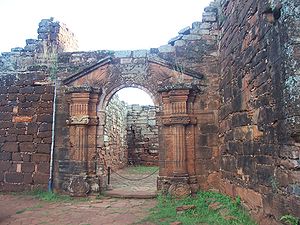
Baroque
The Baroque is a period and the style that used exaggerated motion and clear, easily interpreted detail to produce drama, tension, exuberance, and grandeur in sculpture, painting, literature, dance, and music...
constructions, made by trained indigenous craftsmen, that often remain impressive after over two centuries of abandonment, though the elaborate carved wood interiors have vanished in these cases. The first buildings were usually made in wood, which was sometimes covered with stucco
Stucco
Stucco or render is a material made of an aggregate, a binder, and water. Stucco is applied wet and hardens to a very dense solid. It is used as decorative coating for walls and ceilings and as a sculptural and artistic material in architecture...
decoration imitating stone Baroque architecture. Later, if resources allowed, actual stone buildings would follow, sometimes very large. The Bolivian missions have the best surviving wood and adobe churches. Father Martin Schmid
Martin Schmid
Martin Schmid was a Swiss Jesuit priest, missionary, composer and architect who was active in the Jesuit Missions of the Chiquitos in present day Bolivia....
(1694–1772), a Swiss Jesuit who was a leading figure in the reductions, was both an architect and a composer, and is usually given much of the responsibility for both the later architecture and the remarkable musical life of the reductions.
Mission layout
The ruins of several of the missions still remain. They were laid out in a uniform plan. The buildings were grouped about a central square, the church and store-houses at one end, and the dwellings of the natives, in long barracks, forming the other three sides. Each family had its own separate apartment, but one veranda and one roof served for perhaps a hundred families. The churches were of stone or fine wood, with lofty towers, elaborate sculptureSculpture
Sculpture is three-dimensional artwork created by shaping or combining hard materials—typically stone such as marble—or metal, glass, or wood. Softer materials can also be used, such as clay, textiles, plastics, polymers and softer metals...
s and richly adorned altars, with statuary imported from Italy
Italy
Italy , officially the Italian Republic languages]] under the European Charter for Regional or Minority Languages. In each of these, Italy's official name is as follows:;;;;;;;;), is a unitary parliamentary republic in South-Central Europe. To the north it borders France, Switzerland, Austria and...
and Spain. The priests' quarters, the commissary, the stables, the armory, the workshop, and the hospital
Hospital
A hospital is a health care institution providing patient treatment by specialized staff and equipment. Hospitals often, but not always, provide for inpatient care or longer-term patient stays....
, also usually of stone, formed an inner square adjoining the church. The plaza itself was a level grass plot kept cropped by sheep. The native houses were sometimes of stone, but more often of adobe
Adobe
Adobe is a natural building material made from sand, clay, water, and some kind of fibrous or organic material , which the builders shape into bricks using frames and dry in the sun. Adobe buildings are similar to cob and mudbrick buildings. Adobe structures are extremely durable, and account for...
or cane, with home-made furniture and religious pictures, often made by the natives themselves.
Life at the missions
Smaller missions had two priests, whereas larger missions had more. Populations varied from 2,000 to 7,000. In the morning, children's hymns were followed by Mass and breakfast, after which the workers went to their tasks. "The Jesuits marshaled their neophytes to the sound of music, and in procession to the fields, with a saint borne high aloft, the community each day at sunrise took its way. Along the way at stated intervals were shrines of saints where they prayed, and sang hymns between shrines. As the procession advanced it became gradually smaller as groups of Indians dropped off to work the various fields and finally the priest and acolyte with the musicians returned alone" (Graham, 178–9). At noon each group assembled for the AngelusAngelus
The Angelus is a Christian devotion in memory of the Incarnation. The name Angelus is derived from the opening words: Angelus Domini nuntiavit Mariæ The Angelus (Latin for "angel") is a Christian devotion in memory of the Incarnation. The name Angelus is derived from the opening words: Angelus...
, after which came dinner and a siesta
Siesta
A siesta is a short nap taken in the early afternoon, often after the midday meal. Such a period of sleep is a common tradition in some countries, particularly those where the weather is warm....
; work was then resumed until evening. After supper came the rosary and sleep. On rainy days they worked indoors. Frequent festivals with sham battles
Beleaguered Castle
Beleaguered Castle is a solitaire card game played with a deck of 52 playing cards. It is one of the card games touted as "Freecell without cells" because its game play is somehow akin to the popular solitaire computer game but without extra empty spaces to maneuver...
, fireworks, concerts, and dances enlivened the community.
Aside from the main farm, each man typically had his own garden, pursuing agriculture, stock raising, and the cultivation of maté
Yerba mate
Maté, yerba maté or erva maté , Ilex paraguariensis, is a species of holly native to subtropical South America in northeastern Argentina, Bolivia, southern Brazil, Uruguay and Paraguay...
. Jesuits introduced many European trades and arts to their communities. Cotton weavers, tanneries
Tanning
Tanning is the making of leather from the skins of animals which does not easily decompose. Traditionally, tanning used tannin, an acidic chemical compound from which the tanning process draws its name . Coloring may occur during tanning...
, carpenter
Carpenter
A carpenter is a skilled craftsperson who works with timber to construct, install and maintain buildings, furniture, and other objects. The work, known as carpentry, may involve manual labor and work outdoors....
s, tailor
Tailor
A tailor is a person who makes, repairs, or alters clothing professionally, especially suits and men's clothing.Although the term dates to the thirteenth century, tailor took on its modern sense in the late eighteenth century, and now refers to makers of men's and women's suits, coats, trousers,...
s, hat makers, coopers
Cooper (profession)
Traditionally, a cooper is someone who makes wooden staved vessels of a conical form, of greater length than breadth, bound together with hoops and possessing flat ends or heads...
, boat
Boat
A boat is a watercraft of any size designed to float or plane, to provide passage across water. Usually this water will be inland or in protected coastal areas. However, boats such as the whaleboat were designed to be operated from a ship in an offshore environment. In naval terms, a boat is a...
builders, silversmith
Silversmith
A silversmith is a craftsperson who makes objects from silver or gold. The terms 'silversmith' and 'goldsmith' are not synonyms as the techniques, training, history, and guilds are or were largely the same but the end product varies greatly as does the scale of objects created.Silversmithing is the...
s, musician
Musician
A musician is an artist who plays a musical instrument. It may or may not be the person's profession. Musicians can be classified by their roles in performing music and writing music.Also....* A person who makes music a profession....
s and makers of musical instruments, painter
Painting
Painting is the practice of applying paint, pigment, color or other medium to a surface . The application of the medium is commonly applied to the base with a brush but other objects can be used. In art, the term painting describes both the act and the result of the action. However, painting is...
s, and turners could sometimes be found. They also had printer
Printer (publisher)
In publishing, printers are both companies providing printing services and individuals who directly operate printing presses. With the invention of the moveable type printing press by Johannes Gutenberg around 1450, printing—and printers—proliferated throughout Europe.Today, printers are found...
s, and manuscript
Manuscript
A manuscript or handwrite is written information that has been manually created by someone or some people, such as a hand-written letter, as opposed to being printed or reproduced some other way...
s were also produced by hand copying (Graham).
The goods that were produced at the missions, including cattle, were sold in Buenos Aires
Buenos Aires
Buenos Aires is the capital and largest city of Argentina, and the second-largest metropolitan area in South America, after São Paulo. It is located on the western shore of the estuary of the Río de la Plata, on the southeastern coast of the South American continent...
and other markets under the supervision of the priests. The proceeds earned were divided among a common fund, the workers, and dependents.
Much emphasis was placed on education, as early training was regarded as the key to future success. (Page 503) Much of the instruction was conducted in Guaraní, which was still the prevailing language of the country, but Spanish
Spanish language
Spanish , also known as Castilian , is a Romance language in the Ibero-Romance group that evolved from several languages and dialects in central-northern Iberia around the 9th century and gradually spread with the expansion of the Kingdom of Castile into central and southern Iberia during the...
was also taught.
Jesuit Reductions by country
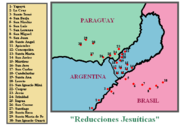
Argentina
- San Ignacio MiniSan Ignacio MiníSan Ignacio Miní was one of the many missions founded in 1632 by the Jesuits in the Americas during the Spanish colonial period near present-day San Ignacio valley, some 60km north of Posadas, Misiones Province, Argentina....
in Misiones ProvinceMisiones ProvinceMisiones is one of the 23 provinces of Argentina, located in the northeastern corner of the country in the Mesopotamiсa region. It is surrounded by Paraguay to the northwest, Brazil to the north, east and south, and Corrientes Province of Argentina to the southwest.- History :The province was... - Nuestra Señora de Santa AnaNuestra Señora de Santa AnaReducción de Nuestra Señora de Santa Ana was one of the many missions or reductions founded in the 17th century by the Jesuits in the Americas during the Spanish colonial period....
in Misiones Province - Nuestra Señora de LoretoNuestra Señora de LoretoReducción de Nuestra Señora de Loreto was one of the many missions or reductions founded in the 17th century by the Jesuits in the Americas during the Spanish colonial period....
in Misiones Province - Santa María la MayorSanta María la MayorReducción de Santa María la Mayor , located in the Santa María Department of the Misiones Province, Argentina, at approximate coordinates , was one of the missions or reductions founded in the 17th century by the Jesuits in the Americas during the Spanish colonial period.-Jesuit Reductions:The...
in Misiones Province - Jesuit Block and Estancias of CórdobaJesuit Block and Estancias of CórdobaThe Jesuit Block and Estancias of Córdoba are a former Jesuit reduction built by missionaries in the province of Córdoba, Argentina, named a World Heritage Site in 2000....
in CórdobaCórdoba, ArgentinaCórdoba is a city located near the geographical center of Argentina, in the foothills of the Sierras Chicas on the Suquía River, about northwest of Buenos Aires. It is the capital of Córdoba Province. Córdoba is the second-largest city in Argentina after the federal capital Buenos Aires, with...
Bolivia
- San Xavier
- Concepción
- San Ignacio de VelascoSan Ignacio de VelascoSan Ignacio de Velasco, San Ignacio, or SIV is the capital of the José Miguel de Velasco Province and the San Ignacio de Velasco Municipality in the Santa Cruz Department of Bolivia.-People:...
- Santa Ana de VelascoSanta Ana de VelascoSanta Ana de Velasco is a small town in the Santa Cruz Department of the South American Andean Republic of Bolivia.- Location :...
- San Miguel de VelascoSan Miguel de VelascoSan Miguel de Velasco or simply San Miguel is a town in the Santa Cruz Department, Bolivia. It is the capital of San Miguel Municipality, the second municipal section of José Miguel de Velasco Province. It is known as part of the Jesuit Missions of the Chiquitos, which is declared in 1990 a World...
- San Rafael de VelascoSan Rafael de VelascoSan Rafael de Velasco or San Rafael is the seat of the San Rafael Municipality in the José Miguel de Velasco Province, Santa Cruz Department, Bolivia. It is part of the Jesuit Missions of the Chiquitos. In 1990 it was declared a World Heritage Site ....
- San José de ChiquitosSan José de ChiquitosSan José de Chiquitos or simply San José is the capital of Chiquitos Province in the Santa Cruz Department, Bolivia. It is known as part of the Jesuit Missions of the Chiquitos, which is declared in 1990 a World Heritage Site, as a former Jesuit Reduction.- External links :* * *...
External links
- Article by Alan Rinding on Brazil's Indians
- Indigenous Genocide in the Brazilian Amazon
- In-depth 1913 Catholic Encyclopedia article on the Reductions
- Colonial Brazil: The Portuguese, the Tupi, and other indigenous tribes
- Detailed description of the Jesuit reductions in Chiquitanía with pictures
----

